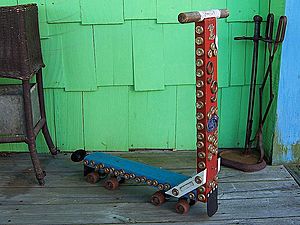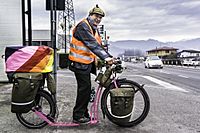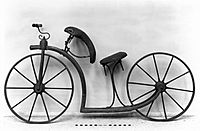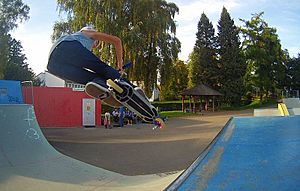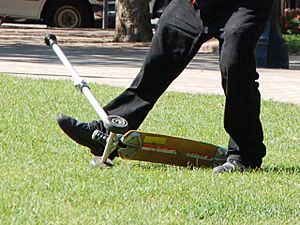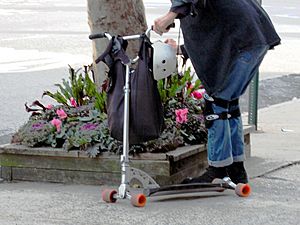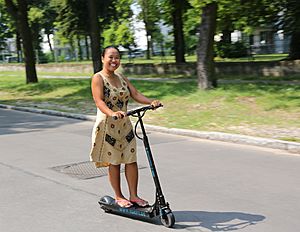Kick scooter facts for kids
A kick scooter (also called a push-scooter or just scooter) is a fun way to get around! It's a vehicle powered by you. You stand on a flat board (the deck) and push off the ground with one leg. Scooters have handlebars and wheels.
Today, most scooters are made from strong materials like aluminum, titanium, and steel. Some scooters for younger kids have 3 or 4 wheels and are made of plastic. These often don't fold up. There are also special, high-performance scooters called kickbikes.
You might also see motorized scooters. These have an engine or an electric motor. They can go quite fast, sometimes over 30 kilometers per hour (about 18 miles per hour)!
Contents
The Story of Kick Scooters

Scooters from the Past
People have been making kick scooters by hand for a long time. They appeared in cities in Europe and the United States as early as the 1920s. Kids often made them for playing in the streets.
A common homemade scooter used roller skate wheels. These wheels were attached to a wooden board with a handle, often an old box. To turn, riders would lean or use another board that could pivot. These early scooters were all wood. Their small wheels had ball bearings inside. They also made a loud noise, which made them feel like a "real" vehicle!
Old records from Germany show that both homemade and factory-made scooters were used. Children even raced them in cities like Paris and Berlin in the 1930s and 1940s. A short movie from 1922 called "A Trip Through the Streets of Amsterdam" shows several children riding scooters.
The Honda Kick 'n Go
In 1974, the Honda company created a unique scooter called the Kick 'n Go. Instead of pushing off the ground, you pushed a pedal on a lever to make it go. It seemed like just as much work as a regular scooter. But it was new and exciting, so it became very popular! People also started to see how useful kick scooters could be for getting around.
Scooters with Air-Filled Tires
Before bicycles became super popular with kids, steel scooters with two small bicycle wheels were common. Around 1987, many companies that made BMX bikes also started making BMX-like scooters. Most of these companies stopped making scooters later. However, some new scooter companies started up and are still around today.
These scooters are still used in busy cities. They are faster than folding scooters and easier to use than a utility bicycle. Some are even made for riding off-road, like "mountain scooters." Besides riding for fun or commuting, large-wheel scooters are great for dog scootering. This is where dogs, like huskies, pull the scooter and rider, just like they pull a sled in the snow! Some Amish people are not allowed to ride bicycles, so they ride scooters instead.
The Kickbike
In 1994, the Kickbike was invented in Finland. This changed how people saw scooters. The Kickbike has a large front wheel, like a standard bicycle wheel. But it has a much smaller rear wheel. This design allows for a much faster ride! There's even a competition called the Footbike Eurocup, which has been held since 2001.
Folding Scooters
In 1990, a new type of scooter was created in Switzerland by Wim Ouboter. It was a foldable aluminium scooter with wheels like those on inline skates. This scooter was sold under names like "Micro Skate Scooter" and "Razor." The Razor scooter first came to Japan in 1999. Many young Japanese people used it for easy travel. Soon, it became a worldwide craze! These small, foldable scooters also became popular toys for children everywhere.
Pro Scooters
Some kick scooters are made for extreme sports, like stunts and tricks. These are called pro scooters or stunt scooters. They are built to be very strong and handle lots of stress. Many brands specialize in making these scooters and their parts. You can find lightweight and super strong parts, helmets, pads, ramps, and more for pro scootering.
Three-Wheeled Scooters
Scooters with three wheels, similar to tricycles, have been made for young children.
In 1999, Micro Mobility Systems and K2 Sports created a three-wheeled scooter called the "Kickboard." This scooter had two wheels at the front and one at the back. Micro also made similar children's scooters called "Mini Micro" and "Maxi Micro." Having two wheels at the front makes the scooter more stable. The Mini Micro uses a special system where you lean the handlebars to steer the wheels. This is called "lean and steer."
Four-Wheeled Scooters
The very first scooters, made from roller skates, actually had four wheels, just like skateboards.
Around the year 2000, a Swiss company made a four-wheeled scooter called the "Wetzer Stickboard." It was like a narrow skateboard with a foldable pole at the front.
In 2006, a company called Nextsport started making a line of four-wheeled scooters called Fuzions. These scooters are usually bigger and heavier than Razor or Micro models. Early Fuzion scooters had large, wide wheels and a big deck for stable riding. Later Fuzion models, like the Fuzion NX, had smaller, harder wheels and handlebars that could spin all the way around.
Electric Kick Scooters
Around the year 2000, electric scooters became more popular than gas-powered ones. Many electric kick scooters are made for rental services, like Lime e-scooters.
Electric kick scooters are great for the environment! They don't create greenhouse gases, which helps keep our air clean. They can also help reduce traffic jams and the need for public transportation. Electric kick scooters have a huge potential to be one of the most eco-friendly ways to travel.
Images for kids
See also
 In Spanish: Patinete para niños
In Spanish: Patinete para niños


